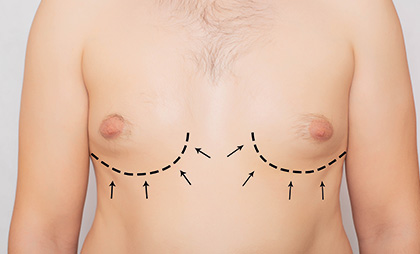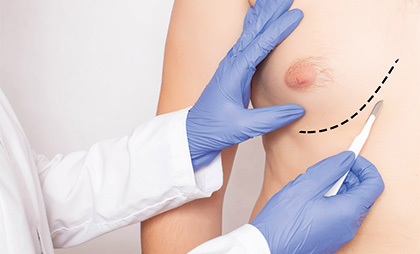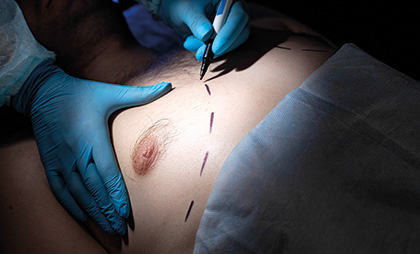What Is A Gynecomastia Condition
Gynecomastia is a condition characterized by the abnormal enlargement of male breasts, often observed in middle-aged and older men. Various factors can contribute to its occurrence, including hormonal imbalances, excessive use of anabolic steroids, and changes in hormone levels associated with liver diseases. Fortunately, modern advancements in cosmetic medicine have made it easier for men to address this issue.
Cosmetic surgeons are now capable of efficiently treating numerous gynecomastia patients on a daily basis. The procedure typically involves making small incisions on both sides of the chest using advanced cosmetic techniques. Through these incisions, the surgeon removes excess fat and glandular tissue from the breast area, subsequently reshaping the chest to achieve a more natural appearance.
While some men may find relief from gynecomastia through weight loss, this approach often proves ineffective due to the inability to eliminate excess glandular tissue solely through weight reduction. Consequently, surgical removal remains a common and effective
solution for addressing gynecomastia.



Techniques Used In Gynecomastia Operation
Advancements in plastic surgery and associated technology have led to the adoption of three distinct techniques for treating gynecomastia in men. The selection of the surgical approach depends on factors such as the patient’s condition and the extent of the gynecomastia.
Techniques used in surgeries to remove gynecomastia in men include:
- Liposuction involves the extraction of excess fat and glandular tissue beneath the breast using Vaser technology, which eliminates fat.
- Surgical Removal entails the complete removal of the breast along with fatty and glandular tissue, performed with an endoscope.
- Integration Technology combines aspects of the previous two techniques.
A laser is utilized to dissolve accumulated fat and break down subcutaneous breast tissue. The success of these surgeries largely hinges on the skill and proficiency of the surgeon. While non-surgical approaches like certain medications, exercise, and a healthy diet exist for treating gynecomastia, they may not be universally effective. Consequently, surgical removal remains a swift and effective solution for addressing gynecomastia in men.
Candidates For Gynecomastia Operation
Men may be caught off guard by unexpected alterations in their breast area. These unusual changes can trigger anxiety as they grapple with uncertainty about the causes and implications. Those afflicted with gynecomastia are often deemed eligible for surgery. Symptoms of gynecomastia in men include:
- Unusual enlargement of the male breast.
- Evident swelling and protrusion of breast tissue, often accompanied by inflammation.
- Sensitivity and discomfort upon applying pressure to the breast region.
- Presence of glandular clusters and sebaceous glands beneath the nipples.
- Observable nipple protrusion as it nears ossification.
- Occasional overall sagging of breast tissue.
- Discharge from one or both nipples.
- Development of sores in the breast vicinity.
Pre-Gynecomastia Operation Tips
If you encounter any of the aforementioned symptoms, it’s crucial to promptly seek medical attention from your doctor. This allows the doctor to assess the extent and progression of gynecomastia. Additionally, a physical examination is conducted to evaluate the patient’s overall health in preparation for any necessary surgical intervention.
Before undergoing gynecomastia surgery, patients should adhere to certain guidelines:
- Refrain from smoking for a period preceding the operation, typically two weeks to a month.
- Avoid consuming antibiotics, aspirin, and anti-inflammatory medications.
- Steer clear of herbal supplements to minimize the risk of bleeding during surgery.
- Discontinue any medications that could adversely affect the gynecomastia removal procedure.
Stages Of Gynecomastia Operation
The process of male gynecomastia surgery involves several straightforward steps. Following anesthesia, the surgeon creates small incisions on either side of the chest, employing a single technique for gynecomastia removal in men. Through these tiny openings, the physician eliminates excess fat and glandular tissue from the breasts while also sculpting the surrounding contours for a seamlessly natural appearance.




Post-Gynecomastia Operation Tips
Following the doctor’s advice and instructions diligently is crucial for achieving complete recovery from gynecomastia surgery in men without any complications. Here are the essential guidelines to adhere to post-operation:
- Maintain a straight sleeping position to prevent any complications to the wound.
- Ensure adequate rest for a minimum of three days following the surgery.
- Refrain from consuming soft drinks, alcohol, and smoking for a designated period after the operation, typically between two weeks to a month.
- Strictly adhere to the prescribed schedule for painkillers and medication as directed by the doctor.
- Avoid strenuous activities and exercises for the initial two weeks post-surgery to minimize stress on the body.
- Abstain from driving during the initial days after the operation.
- Initially, rely on liquid-based nutrition until gradually reintroducing solid foods into the diet.
Adhering to these instructions meticulously will ensure a smooth recovery process and guarantee optimal results from the surgery.



